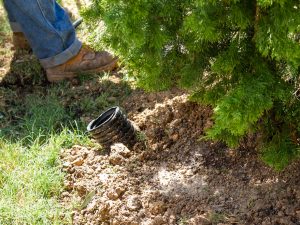How to Install a Soil Moisture Pipe
How to Install a Soil Moisture Pipe
It is critical that soil samples be taken at the correct depth and distance from the trunk. The soil samples should be collected at the bottom corner of the rootball; if the sample is taken too far away from the edge of the rootball or too shallow it can lead us to the wrong results even if it is just a couple of inches away. Here is a chart showing the approximate locations where the samples should be taken:
| Container Size | Distance from Center of Trunk | Depth |
| 15 Gallon | 11 Inches | 12 Inches |
| 20 Gallon | 14 Inches | 15 Inches |
| 30 Gallon | 14 Inches | 15 Inches |
| 45 Gallon | 17 Inches | 17 Inches |
| 65 Gallon | 18 Inches | 18 Inches |
| 95 Gallon | 21 Inches | 21 Inches |
| 200 Gallon | 26 Inches | 24 Inches |
Using either a post hole digger or spade shovel, start digging an 8”-10” wide hole along the side of the rootball. If you don’t see the edge of the rootball then dig a few inches closer to the rootball until it is found. Once found, then we need to continue digging until the bottom of the rootball is reached and at that point we can stop digging the hole any deeper. In the hole we recommend that customers install a 4” or 6” corrugated drain pipe (with slots or perforations) vertically along the edge of the rootball. The reason that we need the pipe to be perforated is so that water can freely drain into and out of the pipe and any excess water at the bottom of the rootball which can easily be drained using a shop vac or a hand pump. The pipe should run from the base of the rootball all the way up to the ground level. Make sure the pipe touches the edge of the rootball along the entire length of the pipe and that the pipe isn’t installed deeper than the rootball. Once the pipe is placed into the hole, then dirt can be filled around the pipe (make sure not to add any dirt into the pipe).

Having the pipe installed will allow us to have easy access to the bottom of the rootball and we can quickly identify whether the tree is being over or under watered. The easiest way to check the soil moisture level is to put a stick down to the bottom of the drainage pipe, which you can purchase at Home Depot. If the ground is hard and there is no dirt that adheres to the stick then the sample is too dry and the gallons should be increased. If the soil adheres to the stick and it has a soft and pliable texture then that indicates that the correct number of gallons are being applied each watering. If there is water on the stick or the soil feels muddy then we know that too many gallons are being applied per watering the soil needs more time to drain before obtaining a playdoh like texture. Additionally, a french drain cap can be added to the top of the pipe which will prevent any critters from getting access into the pipe.
We don’t recommend that customers use soil moisture meters or soil probes. The problem with meters is that they give us readings and we have no idea what those readings mean and the bigger issue is that once they are inserted into the ground they can be a few inches from the rootball and that gives us totally different results. For example, we had a customer that was using a soil probe to retrieve the soil samples and he was using the dimensions from our chart (see above). After extracting the soil sample, it looked like Play-Doh, which is exactly what we are looking for. The problem is that the tree was telling us that it wasn’t happy and it was showing signs of being overwatered. We then instructed the customer to dig a hole next to the rootball and upon digging the hole he said that the soil felt like Play-Doh. After questioning the customer further, we found out that the hole was not right next to the rootball (he was about 2” away from the rootball). So, we told him to dig closer to the tree until he found the rootball and then dig all the way down and as he approached the bottom of the rootball water suddenly starting gushing into the hole.


 Treeland Nursery
Treeland Nursery
972-372-4737
Facebook Twitter Pinterest Instagram Youtube Houzz